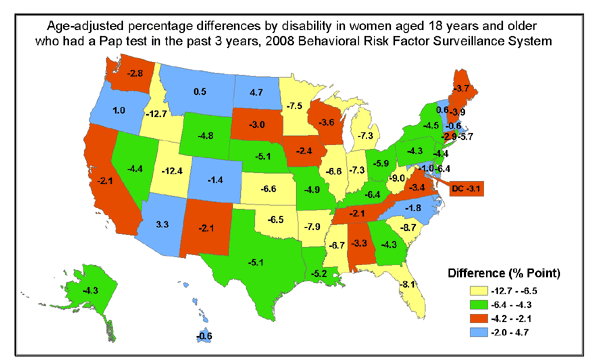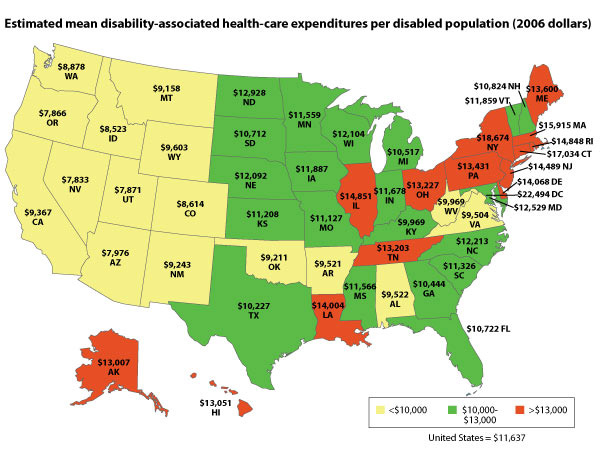Health Care Data & Statistics
Breast and Cervical Cancer Screening
In the United States in 2008:
- An estimated 22.4% of women 18 years of age or older and 29.3% of women 40 years of age or older had a self-reported disability.
- Women 40 years of age or older with a disability were less likely to have had a mammogram (72.2%) than were women without a disability (77.8%).
View your state's percentage differences in women who had a mammogram.
 D
D
- Significantly fewer women with a disability (78.9%) reported receiving a Pap test during the previous 3 years compared with women without a disability (83.4%).
View your state's percentage differences for women who had a Pap test.
 D
D
Urinary Tract Infections Among People Affected by Spina Bifida
[Read summary ]
- People affected by spina bifida averaged 0.5 hospitalizations per year, and there were 22.8 inpatient admissions with urinary tract infections (UTIs) per 1,000 people with spina bifida during the period 2000–2003, in comparison with an average of 0.44 admissions with UTIs per 1,000 people for those without spina bifida.
- If the number of UTI hospitalizations among people affected by spina bifida were reduced by 50%, expenditures could be reduced by $4.4 million per 1,000 patients.
Economic Cost
- In 2006, disability-associated health care expenditures accounted for 26.7% of all health care expenditures for adults residing in the United States and totaled $397.8 billion, with state expenditures ranging from $598 million in Wyoming to $40.1 billion in New York. Of the national total:
- Medicare paid $118.9 billion.
- Medicaid paid $161.1 billion.
- Non-public sources paid $117.8 billion.
In part, the magnitude of disability-associated health care expenditures stemmed from the high prevalence of disability among the adult population, with 18.2% of all adults reporting a limitation in some way in at least one activity because of physical, mental, or emotional problems.
View your state's economic costs for disability-associated health-care expenditures.
 D
D
Contact Us:
- Centers for Disease Control and Prevention
National Center on Birth Defects and Developmental Disabilities
Division of Human Development and Disability
1600 Clifton Road
MS E-88
Atlanta, GA 30333 - 800-CDC-INFO
(800-232-4636)
TTY: (888) 232-6348
New Hours of Operation
8am-8pm ET/Monday-Friday
Closed Holidays - cdcinfo@cdc.gov



